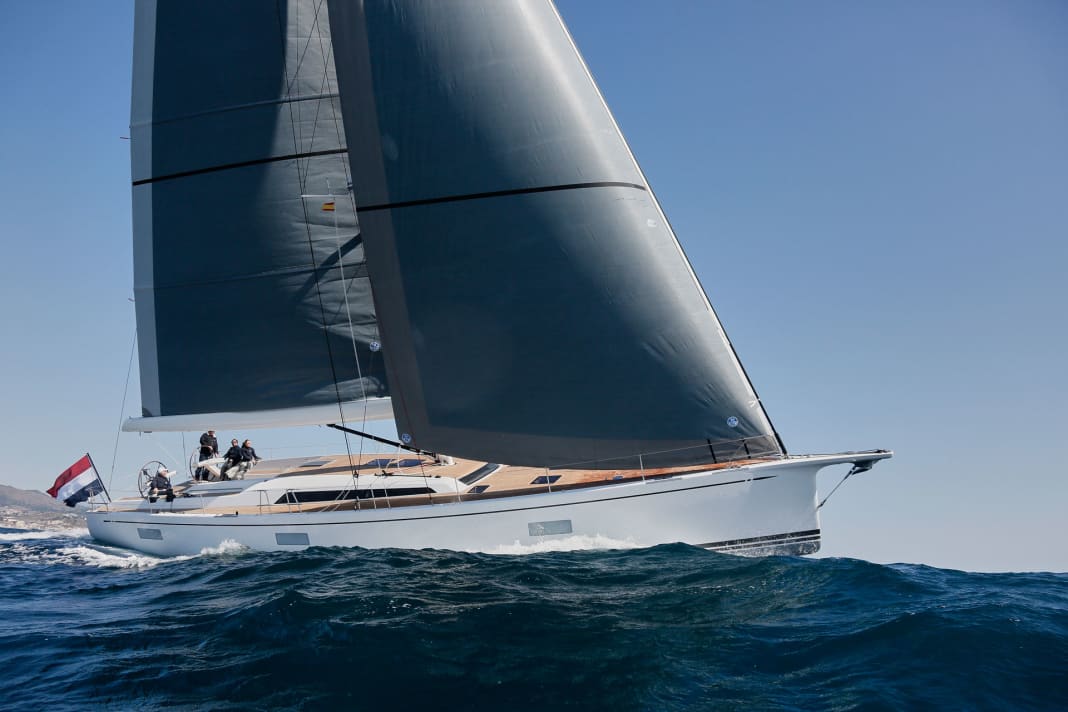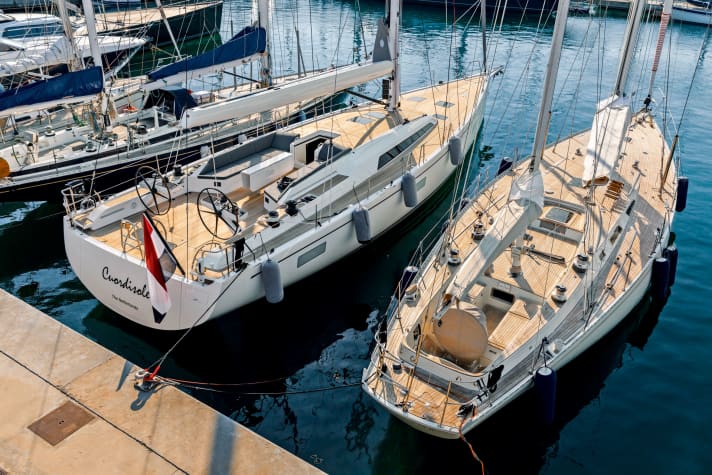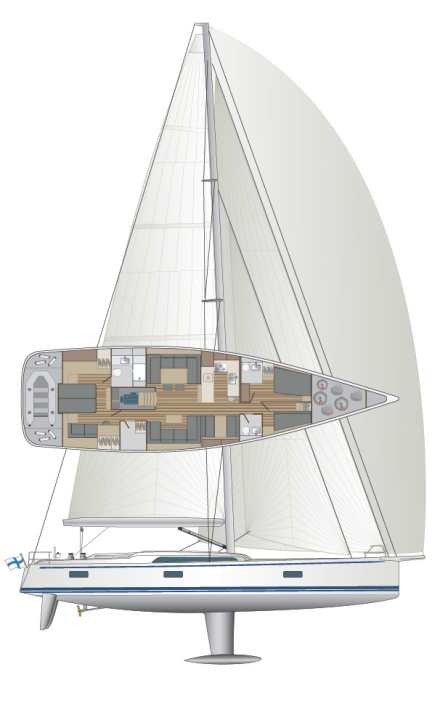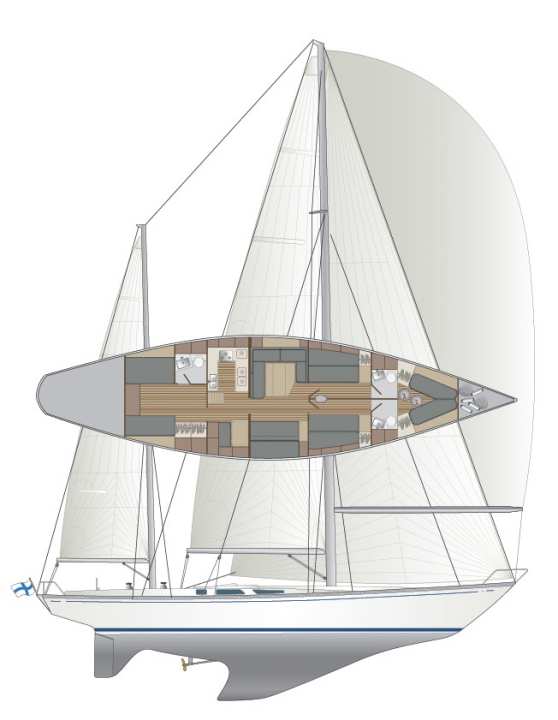





When the Mexican dark green ketch "Sayula II" crossed the finish line off Portsmouth in southern England at teatime on 17 April 1974, it made sailing history. With the finish, an adventurous crew of amateurs and experienced sailors surprisingly won the first team race around the world, the legendary Whitbread Round the World Race, which later became the Volvo Ocean Race.
The victory of the Swan 65 is the accolade for the Nautor shipyard in Finland, founded eight years earlier by Pekka Koskenkyla, as well as for the material GRP, which until then was considered unsuitable and above all untrustworthy for large seaworthy yachts. Curiously, the project manager for the development of the Swan 65 was Per Göran Johansson, who tried to convince his bosses at the time of the new sandwich construction method, but was unable to prevail. Although "Sayula" was solidly laminated and successful with this construction method, Johansson and four other Nautor technicians split up and founded Baltic Yachts in the immediate neighbourhood, which was successful with its modern lightweight construction and became a major competitor - true to the motto "The biggest critics of moose used to be moose themselves" (F. W. Bernstein). Nevertheless, the Swan 65, the largest production boat of its time, was built 41 times - an almost unheard-of success.
The new Swan 65 aims to build on past successes
Some 50 years later, sandwich construction has long been the industry norm in upmarket boatbuilding, and a 65-foot cruising yacht is part of the standard repertoire for shipyards such as Nautor, Baltic, Wally, Oyster and Huisman. The Swan shipyard is now owned by a group of investors led by Italian fashion designer Leonardo Ferragamo, who have set themselves the goal of bringing Nautor back to the forefront of the boatbuilding industry. To this end, the brand relies on a lively regatta programme with its own racing calendar, mainly in the Mediterranean, and the performance cruisers in the ClubSwan series with the successful 50, the spectacular 36 with C-foils and ultra-flexible mast and the 125, which is still in the planning stage.
Other interesting cruising yachts:
The Swan 65 made its world premiere at boot Düsseldorf 2019, but was only presented to invited guests there as the owner wanted to avoid a crowd in his private rooms. She was then lorried directly from the world's largest water sports show to Barcelona, where she was refloated by Nautor's service partner EMV Marine.
At the time of our visit in spring 2019, she was basking in the spring sunshine in the immediate vicinity of an edition of her famous predecessor, a Swan 65. What once appeared large and mighty is now curiously petite in comparison to the current 65. The older hull shows the typical long overhangs of the Sparkman & Stephens era, the classic lines that still originate from wooden boat building.
Details on board the cruising yacht
The stern is narrow, as is the boat, and the freeboard is low. 20 winches can be counted on deck, 20! The old cruising yacht sailed in the dark ages, when there were no good lever clamps, and the motto was: one winch per halyard, per sheet, per line. The crew worked with ropes as thick as an arm (which nevertheless stretched badly), galvanised (rusting) or stainless steel (meat hook-producing) wire and sails made of the heaviest (but stretching) Dacron. The designers parcelled out the sail area into more manageable sections using two masts, thereby utilising measurement advantages. The bulky cloths were not turned away or furled, but simply adjusted by changing the wind force and angle of incidence. In the legendary documentary film about the "Sayula" ("The Weekend Sailor"), the participants recall a phase in which 150 sail changes were carried out within three days.
The sailors struggled with the main, mizzen, various genoas and jibs, a mizzen staysail, the tall boy, various spinnakers and a blooper. In addition, two spinnaker poles in telegraph mast format and the smaller jockey poles for better leech angles. The rugged decks of those archaic times, with their various rails, deflectors and other fittings, gave rise to the myth that sailing barefoot would lead to certain death by injury.
It took several men to move a Dino like this, even in holiday or transfer mode. With a full crew it was cramped on board, the small deep cockpit offered space for three, the rest scurried around on the long bridge deck or directly on the masts, where some of the halyard winches are mounted.

Two times Swan 65 in comparison
Next to it is the new one: masculine, striking, powerful. Product Manager Vanni Galgani emphasises that the hull does not twist when in the water and is optimised for a comfortable 20 degree heel. The mast is positioned far aft, the J is longer than the boom, plus the bowsprit - this opens up the possibility of many headsails, including a staysail or an optional self-tacking jib. The stern is almost as wide and open as possible, with a dinghy garage underneath. Two wheels, two rudder blades, of course, given the width. A huge cockpit with plenty of space between the transom and the wheels, which are laminated from a visually and haptically appealing wood-carbon mix. All lines run aft through the superstructure, controlled by effective spinlock stoppers on pressure pot-sized winches, which can also be operated electrically in the cockpit and from the wheels. Naturally, there is no wire on board, only low-stretch, lightweight and wonderfully easy to work with Dyneema material.
The mainsheet does not require a traveller; it is attached to a flush fitting on deck with a swap shackle and runs through the boom and mast into the ship, where it is tamed by an electric winch with proportional drive. The alternative is a winch island in the cockpit, which operates a 1:2 reduced mainsheet. A total of 225 ampere hours are stored for sail handling alone, with a full 720 ampere hours available for the other consumers, all on a 24-volt basis. And of course, in addition to the 150 hp Volvo Penta engine, there is also an 11 kilowatt generator for recharging.
The strengths of the new cruising yacht
Unlike the original Swan 65, the new cruising yacht can be sailed and even manoeuvred alone. Extendable thrusters in the bow and, if desired, in the stern push the boat where the skipper wants it to go, despite the wind. Of course, the skipper is also assisted by a machine when hoisting and lowering the sails. The mainsail can be retracted into the boom, where it is wound around a carbon tube. This is an option. A carbon rig from Axon is already on board as standard. The owner of number 1, a Dutchman with a lot of sailing experience from the Brunel team of the last Volvo Ocean Race (which brings us back full circle to the "Sayula"), then reached one shelf higher and ordered a Hall mast with ECsix rigging, both made of carbon.
The man knows what is good and expensive and proved to be a stroke of luck for the shipyard. He ordered a telescopic keel, enabling Nautor to present a very sophisticated option in the form of construction number 1. When fully extended, the fin with the thick bomb reaches a depth of 4.20 metres. At the push of a button, the hydraulics pull the hollow lower section over the somewhat narrower upper segment. The process takes about a minute. The keel, which in contrast to a lifting keel does not disturb the interior in any way, is only designed for motoring and anchoring in shallow waters and harbours, not for sailing. The conventional fixed keel is 3.50 metres deep, the shallow version 2.90 metres.
Sailing fun and innovation
The comparison of cracks and data also reveals exciting things. While the greatest width of the old Schwan is almost exactly half the length of the ship, BMax is found further aft on the new one, and the hull hardly tapers at all. While the "Sayula" design with its long keel root and rudder blade and huge skeg was obviously only just taking the tentative step towards a split lateral plan at the time, the contemporary model demonstrates the consistent separation of the two keel functions of lateral surface and ballast carrier. The narrower older boat is around three tonnes heavier and carries a higher proportion of ballast. The sail carrying figures also show the new boat to be the faster, sportier one. With the (dimensionless) value of 4.6, the predecessor ranks at today's standard performance cruiser level, while the new boat has the genes of a racer.
On board the cruising yacht and underway, the respect quickly gives way to a sense of sailing fun that not all large boats can offer. 14 to 16 knots, spring sunshine and long, high waves create a backdrop that couldn't be more pleasant. The main and genoa are unfurled electrically, the boat drops to an approach course and the 20 tonnes accelerate to a full eleven or twelve knots virtually from a standing start. These values are maintained almost continuously. The boat eats up the miles; long trips, for example transatlantic, must be a blessing with this boat.
This cruising yacht is modern and timeless
The sail management works perfectly. The large 80 mm Performa winches from Harken do an excellent job, and the winch that furls and unfurls on joystick command is a marvellous trimming instrument. The longer you hold the lever, the faster it works. At the wheel, the helmsman stands securely on fold-out platforms that compensate for the inclined position. His gaze wanders over an unobstructed deck. Even the genoa rails are mounted on the coachroof and both the centre of gravity adjustment and the sheets are invisibly routed aft in channels.
All in all, the Swan 65 cruising yacht is at the cutting edge, just like the "Sayula" series 45 years ago. Of course, it is built as a sandwich. The hull is made of glass fibre epoxy laminate and foam core using the Sprint process that has been used for years. This is a resin infusion technology based on prepreg, pre-impregnated fibres whose resin film liquefies during tempering. This tried-and-tested system generally guarantees high-quality mechanical properties, very low air entrapment and, at the same time, economical production of the laminate. The deck is also produced using the sprint process, but made entirely from carbon fibre and again with a foam core. As is common in mass production today, it is not fully laminated to the hull, but is bonded to the shell using high-performance adhesive.
The new Swan 65 is customised
All reinforcements and the bulkheads are also produced in this process using carbon fibres. The bulkheads are also laminated from this high-performance material. And the floorboards are made of foam sandwich with real wood veneer. Despite the lightweight construction and all the adaptations from the regatta sector, as well as the option of equipping the boat with a square top and double aft stays, the Swan 65 remains a cruiser.
Naturally, the cruising yacht offers a high degree of customisation - if Hanse, Bavaria and Beneteau already offer a large modular system, Nautor can't afford to be lazy. In addition to many individual questions regarding the equipment and design, the main issue is where the owner's cabin should be positioned. In the foredeck, as in construction number 1, flanked by a separate bathroom and a multifunctional room, customised to your own taste? Or aft across the full width? This would require a bridge deck in the cockpit for the passageway in front of the berth, separating the guest cockpit from the work area. The aft cabins move forwards and the multifunctional space becomes a second wet room.

The five metre long saloon is slightly elevated and offers all-round visibility through a front window. On the port side there is a large table with a sofa, opposite which is a lounge area adjoining the navigation corner. The largest room on board is airy and seems almost too large. Without the handrails under the ceiling, there is a risk of sliding helplessly to leeward, where you would have to remain until the next tack. For a longer passage, measures are still needed here to divide the space.
A look below deck
The galley is recessed into the main bulkhead, opposite which is a second seating area in the form of a dinette - the dining room, so to speak. The ends of the boat are reserved for the technical equipment. Aft is the dinghy garage. Its bulkhead, like the one in the foredeck, is completely watertight, as are the openings for cables and pipes. The foredeck is designed as a sail load on construction number 1. The code zero, gennaker and staysail are stored here and can be hoisted directly to their place of use on deck.
The layout and options allow the owner to configure the cruising yacht for the living situation with or without a paid crew, just as it is conceivable to sail and manoeuvre the boat alone. Assistance systems enable handling by a small, experienced crew, although the size of the boat and the number of technical facilities make it desirable to be able to call on professional help at least sporadically.
The Swan 65 was designed by Germán Frers, who has been working for Nautor since the 1980s and whose designs have been used to build over 700 units. The Argentinian stands for particularly well-balanced, aesthetic yachts. For the Swan 65, he focused on medium displacement, good performance in light to medium winds and a voluminous hull for high dimensional stability and appealing wave behaviour. Frers: "The boat will be successful for a long time. The lines look fresh, clean and contemporary, it doesn't follow any short-lived fashions." The maestro has thus realised the specifications of his client Nautor: the Swan 65 should be beautiful, reliable, comfortable and fast. That worked out well.
That leaves the tedious task of naming the price: the cruising yacht costs 2.95 million euros with the basic equipment. The telescopic keel: 367,000 euros. Both without VAT. All right: at least they deliver a half-model with ...
This article first appeared in YACHT 10/2019 and has been revised for this online version.
Technical data Swan 65

- Designer: Germán Frers
- Hull length: 20.11 m
- Width: 5.62 m
- Draught: 3.50 m
- Weight: 27.3 m
- Sail area downwind: 240.2 m²
- Sail carrying capacity 5.1
More volume and more draught are the main differences. Almost 50 years of yacht building history lie between the once largest Swan and the latest. Today, the shipyard's flagship, the ClubSwan 125, is almost twice as long

- Designer: S & S
- Hull length: 19.68 m
- Width: 4.33 m
- Draught: 2.90 m
- Weight: 31.8 m
- Sail area downwind: 209.2 m²
- Sail carrying capacity 4.6

